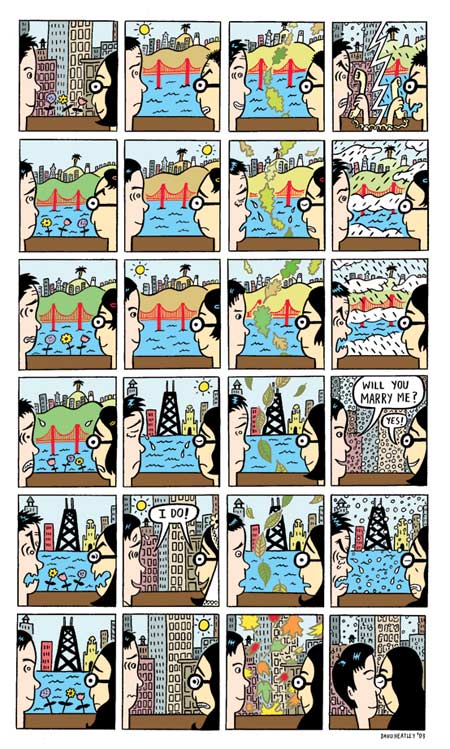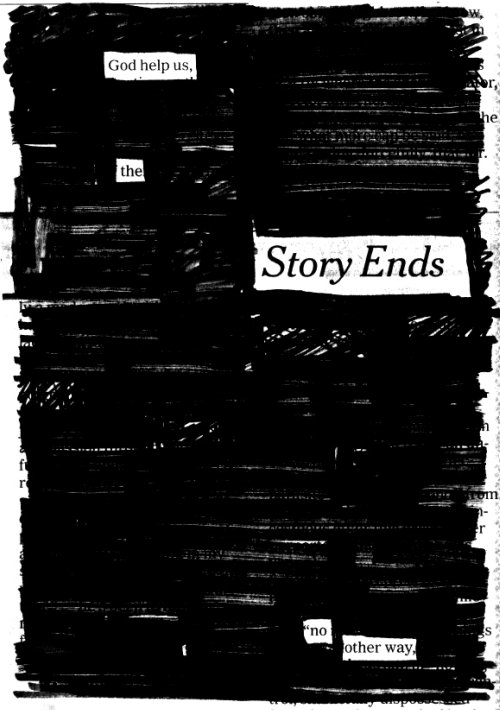
JACK KEROUAC AND ON THE ROAD
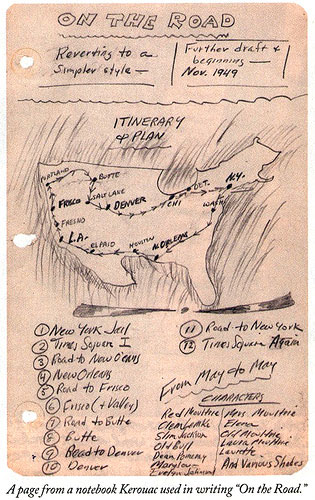
Louis Menand’s article, “Drive , He Wrote: What the Beats were about,” featured in last week’s New Yorker, is probably the best piece about Jack Kerouac’s On The Road that I’ve ever read. Like many a fifteen-year-old boy, On The Road changed my life, and I studied Kerouac until I got to college when I replaced him with another “masculine” idol of literature, Raymond Carver. Ho-hum…
A couple of passages I thought were worth saving:
The book is not about hipsters looking for kicks, or about subversives and nonconformists, rebels without a cause who point the way for the radicals of the nineteen-sixties. And the book is not an anti-intellectual celebration of spontaneity or an artifact of literary primitivism. It’s a sad and somewhat self-consciously lyrical story about loneliness, insecurity, and failure. It’s also a story about guys who want to be with other guys.
(…)
They are not hipsters, either, cats too cool for life in suits. There is nothing cool about Dean or Carlo Marx (the Ginsberg character, Karl converted into a Marx Brother). The characters marry and get legally divorced; they take jobs and quit them; they talk about Dostoyevsky and Hemingway and write novels and poems and hope for recognition. The narrator lives with his aunt, who sends him money when he needs a bus ticket home. Otherwise, he draws on his G.I. benefits. A middle-class life with a house and a wife and kids is what Sal wants, and what Dean would want, too, if he could stop getting in his own way. As Kerouac later insisted, it’s a mistake to read this as an anticipation of the counterculture.
I also dig what Menand has to say about the car:
Nostalgia is part of the appeal of “On the Road” today, but it was also part of its appeal in 1957. For it is not a book about the nineteen-fifties. It’s a book about the nineteen-forties. In 1947, when Kerouac began his travels, there were three million miles of intercity roads in the United States and thirty-eight million registered vehicles. When “On the Road” came out, there was roughly the same amount of highway, but there were thirty million more cars and trucks. And the construction of the federal highway system, which had been planned since 1944, was under way. The interstates changed the phenomenology of driving. Kerouac’s original plan, in 1947, was to hitchhike across the country on Route 6, which begins at the tip of Cape Cod. Today, although there is a sign in Provincetown that reads “Bishop, CA., 3205 miles,” few people would dream of taking that road even as far as Rhode Island. They would get on the inter-state. And they wouldn’t think of getting there fast, either. For although there are about a million more miles of road in the United States today than there were in 1947 (there are also two more states), two hundred million more vehicles are registered to drive on them. There is little romance left in long car rides.
(…)
The car is also a male space. The women who end up being driven in (never driving) the car are either shared by the guys (Marylou, for example, whom Dean hands off to Sal, as Cassady handed off LuAnne to Kerouac) or abandoned (as happens to the character Galatea Dunkel, and as happened to her real-life counterpart, Helen Hinkle). But the car is not an erotic space. Driving is a way for men to be together without the need to answer questions about why they want to be together. (Drinking is another way for men to be together, and there is a lot of drinking in “On the Road.” There is a lot of drinking, period.) In this sense, “On the Road” is a little like another sensational road novel of the time: Humbert and Lolita drive obsessively back and forth across the continent because that is the only public way for them to be together. As long as they’re driving, they’re not doing anything they shouldn’t be doing.
It’s a great article, and well worth reading for any Kerouac fan.
DRAWING THAT SIGNIFICANT OTHER, PART TWO
Like a response to yesterday’s post, “The Artist’s Wife: A Constant Muse Who Never Said No”:
“I never refused when he wanted to take a picture,” said Eleanor Callahan, the 91-year-old widow of the photographer Harry Callahan. “I never complained, whatever I was doing. If he said: ‘Come quick, Eleanor — there’s a good light,’ I was right there.”
The artistic fruit of their 63-year marriage is on view in “Harry Callahan: Eleanor,” an exhibition at the High Museum of Art in Atlanta. Until Callahan’s death in 1999, she was his most constant and compliant subject, posing for countless portraits, figure studies and nudes.
DRAWING THAT SIGNIFICANT OTHER (SCENES OF DOMESTIC BLISS)
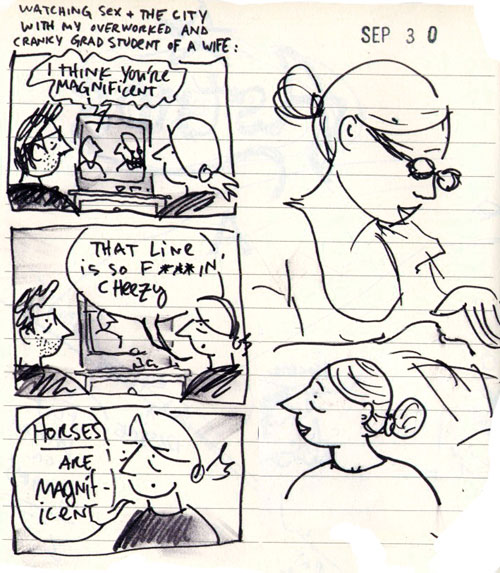
Eddie Campbell’s “Honeybee” comics from his wonderful book, The Fate of the Artist:
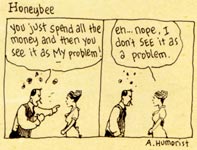
James Kochalka gets away with a tribute to his wife that if I drew it of mine would get me killed:

David Heatley chronicles the seasons of love:
And Lynda Barry draws her family:
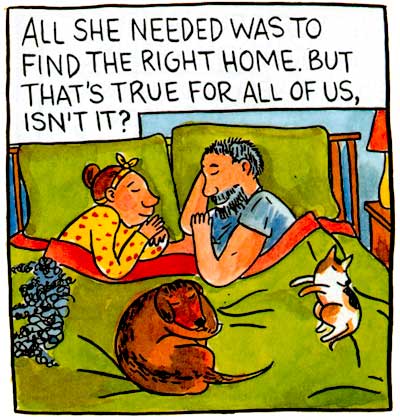
Sappy, I know, but sometimes I am.
THE PIRATES WHO WON THE WORLD FROM INDIANS
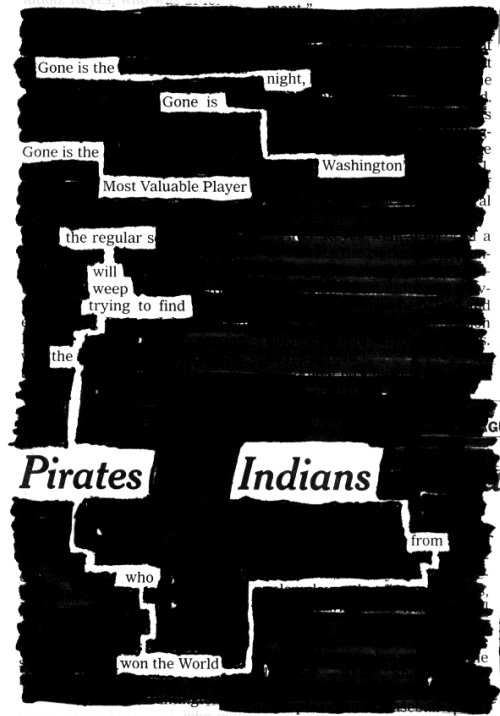
- ← Newer posts
- 1
- …
- 524
- 525
- 526
- 527
- 528
- …
- 635
- Older posts→
